WHO Traces SARS Virus to Civet Cat -
5/23/03
Researchers from the University of Hong Kong
examined 25 animals representing eight species in a live animal market in
southern China and found the virus in all six masked palm civets they sampled,
as well as in a badger and a raccoon dog.
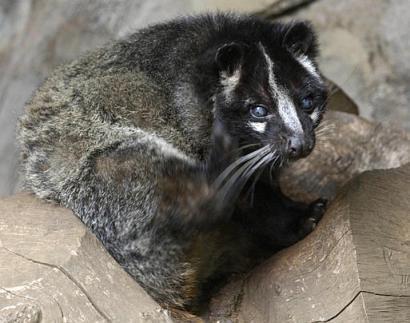 Civet or civet
cat,any of a large group of mostly nocturnal mammals of the Old World
family Viverridae (civet family), which also includes the mongoose.
Civets are not true cats, but the civet family is related to the cat family (Felidae).
Most civets have catlike bodies, long tails, and weasellike faces. Their fur may
be gray or brown, and may be marked in various patterns. All civets have
scent-producing glands, located in a double pouch near the genitals. The fatty
yellow secretion of these glands has a distinctive musky odor used for
territorial marking. Commercially, this substance is known as civet and is used
as a perfume fixative. Civet can be removed from captive animals every 14 to 20
days. Some civet species are hunted for their fur. The ground-living, or true,
civets form a distinctive group within the family; these animals have a highly
carnivorous diet. Most have dark spots and ringed tails. They include several
Asian species (genus Viverra) and one African species (Civettictis
civetta). Best known is the Indian civet, V. zibetha, of S Asia, from
which most of the civet for perfume is derived. It has tawny fur with black
spots and black bands on the tail. It is about 30 in. (76 cm) long, excluding
the 20-in. (42-cm) tail, and about 15 in. (38 cm) high at the shoulder; it
weighs up to 25 lb (11 kg). Its musk glands are greatly enlarged. Some of the
ground-living civets are called linsangs and genets. The palm civets form
another distinct group within the civet family. These are arboreal, largely
fruit-eating animals of Africa and Asia; they are classified in several genera.
The North American spotted skunk is sometimes popularly called civet but is not
closely related to civets. Civets are classified in the phylum Chordata,
subphylum Vertebrata, class Mammalia, order Carnivora, family Viverridae.
Civet or civet
cat,any of a large group of mostly nocturnal mammals of the Old World
family Viverridae (civet family), which also includes the mongoose.
Civets are not true cats, but the civet family is related to the cat family (Felidae).
Most civets have catlike bodies, long tails, and weasellike faces. Their fur may
be gray or brown, and may be marked in various patterns. All civets have
scent-producing glands, located in a double pouch near the genitals. The fatty
yellow secretion of these glands has a distinctive musky odor used for
territorial marking. Commercially, this substance is known as civet and is used
as a perfume fixative. Civet can be removed from captive animals every 14 to 20
days. Some civet species are hunted for their fur. The ground-living, or true,
civets form a distinctive group within the family; these animals have a highly
carnivorous diet. Most have dark spots and ringed tails. They include several
Asian species (genus Viverra) and one African species (Civettictis
civetta). Best known is the Indian civet, V. zibetha, of S Asia, from
which most of the civet for perfume is derived. It has tawny fur with black
spots and black bands on the tail. It is about 30 in. (76 cm) long, excluding
the 20-in. (42-cm) tail, and about 15 in. (38 cm) high at the shoulder; it
weighs up to 25 lb (11 kg). Its musk glands are greatly enlarged. Some of the
ground-living civets are called linsangs and genets. The palm civets form
another distinct group within the civet family. These are arboreal, largely
fruit-eating animals of Africa and Asia; they are classified in several genera.
The North American spotted skunk is sometimes popularly called civet but is not
closely related to civets. Civets are classified in the phylum Chordata,
subphylum Vertebrata, class Mammalia, order Carnivora, family Viverridae.
2. Animal Description: Other Common Names: Cacomistle,
Ringtail Cat, Minerís Cat, Coon Cat, Civet Cat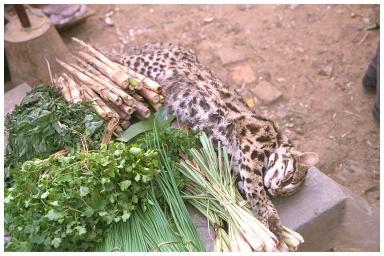
With the tail of a raccoon and the face of a fox, the common
Ringtail is a lovely animal.
In the same family as the raccoon, the Ringtail, is a
fascinating conglomeration of visuals from other animals, but with a
personality all its own! The Ringtail is indigenous to the Southwestern
United States, as well as Mexico and parts of Central America. There are
two distinct species of Ringtail, the first is the species found 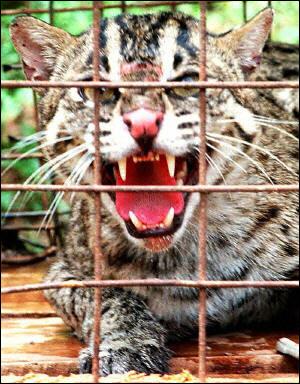 commonly
in the United States and the second is the Mexican species. In the United
States, they range as far north as Colorado and as far east as Texas,
being a fairly common animal. They prefer living in areas with a lot of
trees, but are known to make their homes in other places, such as caves,
rock hollows, and other dark, private places where they can rest and feed
with their mate. They are the state mammal of Arizona, and can be found
sleeping during the day in crevices all along mountainsides in the vast
Arizona desert. Ringtail Cats will line these crevices with soft grasses
or moss. Their diet is made up mostly of smaller animals and insects, like
beetles, and they will occasionally eat fruits and vegetables from nearby
vegetation. Ringtails love to climb trees and leap from branch to branch,
being very fast, agile creatures that can run swiftly from predators and
easily close in on slower-moving prey. They are quiet, solitary animals,
and prefer to live alone. They are nocturnal, and forage for food mostly
at night.
commonly
in the United States and the second is the Mexican species. In the United
States, they range as far north as Colorado and as far east as Texas,
being a fairly common animal. They prefer living in areas with a lot of
trees, but are known to make their homes in other places, such as caves,
rock hollows, and other dark, private places where they can rest and feed
with their mate. They are the state mammal of Arizona, and can be found
sleeping during the day in crevices all along mountainsides in the vast
Arizona desert. Ringtail Cats will line these crevices with soft grasses
or moss. Their diet is made up mostly of smaller animals and insects, like
beetles, and they will occasionally eat fruits and vegetables from nearby
vegetation. Ringtails love to climb trees and leap from branch to branch,
being very fast, agile creatures that can run swiftly from predators and
easily close in on slower-moving prey. They are quiet, solitary animals,
and prefer to live alone. They are nocturnal, and forage for food mostly
at night.
The body of the Ringtail is slender, almost like a
squirrel's, its face holds pointed features that resemble a fox. Head and
body can be about 15 inches long, with the tail being just as long as the
body. The body will be colored a soft yellow-gray color, with the tail
coming in alternating stripes of brown and white. The face of a Ringtail
is marked with dark brown and white, although not in a typical mask
pattern. It has powerful little claws that it can use for climbing,
hunting, and digging and its feet have five toes.
The Ringtail is known by many names. It has been referred to
in the past as the "Miner's Cat", Ringtail Cat",
"Cacomistle", "Coon Cat", and "Civet Cat".
A.【編譯黃秀媛綜合廿三日電訊報導】香港與深圳的專家經過一個月合作研究,23日宣布在亞洲人視為珍饈的果子狸(Masked
Palm Civet)體內,發現與引起SARS的冠狀病毒極為類似的病毒。世界衛生組織
(WHO)說,中國大陸當局已決定禁止出售這些動物,以遏制SARS蔓延和防止再度爆發疫疾。
果子狸在 SARS
疫疾裡扮演的角色仍待探究,不過這項發現對遏制SARS可能是一個重大發展,可以確定這種致命疫疾是如何出現的,並設法消滅自然界可能還隱藏的病毒,以免復發。
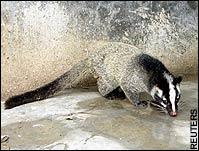 WHO 的 SARS
主管斯多爾說,這種病毒是否存在自然界還不確定,不過如果病毒侷限在養殖動物,那麼只要禁止這種養殖就可以消滅病毒來源,減少日後從動物傳染給人類的可能性。他說:「我們相信現在還來得及撲滅這種疾病,在確定動物來源後,這種可能性更大。」
WHO 的 SARS
主管斯多爾說,這種病毒是否存在自然界還不確定,不過如果病毒侷限在養殖動物,那麼只要禁止這種養殖就可以消滅病毒來源,減少日後從動物傳染給人類的可能性。他說:「我們相信現在還來得及撲滅這種疾病,在確定動物來源後,這種可能性更大。」
自去年 11
月廣東出現 SARS
疫情以來,科學家即猜測這種疾病可能來自某種原來存在動物體內的病毒,並經過突變傳染給人類。
香港大學和深圳疾病預防控制中心研究小組,在深圳市場購買和檢驗分屬八種類別的
25
隻動物,並在其中六隻果子狸的唾液和糞便裡,發現類似SARS病毒。一隻貉(raccoon
dog)的排泄物裡也有此種病毒,一隻鼠獾(badger)
血液裡則有病毒的抗體。
他們對果子狸的病毒進行基因分析,發現與
SARS
病毒幾乎完全相同,只是前者多出
29
個鹼基對。這些鹼基形成的基因,能夠發出指令製造一種蛋白質,以形成病毒部分外殼。
斯多爾說,失去這個基因,可能是使病毒能夠傳染給人類,並在人類之間迅速傳播的突變。
香港大學微生物系主任袁國勇說,果子狸的排泄物和呼吸道有極為大量這種病毒,可是牠們本身不受影響,但是畜養或宰殺動物的人有可能感染病毒,因此處理必須小心。
由於譯名的關係,幾家國際通訊社都把果子狸譯成麝貓(civet
cat)。台北木柵動物園園長陳寶忠說,這兩者雖然都屬於靈貓科動物,可是並不同種,果子狸鼻部有一道白色紋路,因而又稱白鼻心。
B. 動物身上發現SARS病毒
WHO籲勿太早下定論
【中央社倫敦二十三日美聯電】
5/23/03
針對香港研究人員在某些動物身上發現嚴重急性呼吸道症候群SARS病毒,世界衛生組織
WHO 專家說:"現在就下定論未免太早,不過,此一發現確實頗令人振奮。"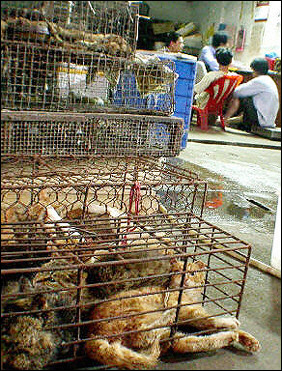
香港的研究人員在三種小動物身上發現引發SARS的冠狀病毒,其中一種動物是頗受部分華人喜愛的佳餚果子狸。
WHO研究可傳到人體的動物疾病計劃的負責人梅斯林接受記者電話訪問說,WHO無法排除這些動物從人類身上感染這種病毒的可能性,也有可能這種病毒是從其他動物傳給人類與這些動物。
香港大學的研究人員,針對廣東省專門提供給華人餐館烹調佳餚的二十五隻八種不同動物進行檢查。一般咸信SARS疫情係從廣東省爆發。
WHO首席SARS病毒學家史托爾說,檢驗的動物中有六隻果子狸,檢驗結果對類似SARS的病毒全部都呈現陽性反應。
有一隻東亞狸的排泄物也檢驗出有SARS病毒,以及抗病毒的抗生素。另外並在一隻獾身上檢驗出抗生素。
史托爾說,其中以在果子狸身上檢驗出的SARS病毒最為明確。
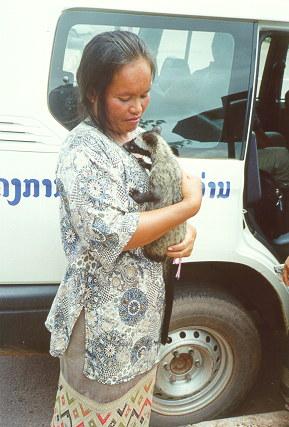
(a woman with civet cat)
The Malay civet or Tangalung is the most common and best-known of the
civets. It comes scavenging around longhouses and forest camps or hunts rats in
plantations at night, and the prominent black and white markings on its throat
show up well in torch light. The rest of its body is covered with black spots,
merging into a black stripe along its back which extends right to the tip of the
tail. In the forest, it spends much of its time on the forest floor feeding on
insects and other invertebrates as well as small vertebrates. Like other civets,
the Tangalung marks out its territory: it defecates at specific locations
(called "civetries") near its main routes, where it borders on the
territory of its neighbours.
DID YOU KNOW...?
- Civets are very agile tree-climbers.
- Fruit is a major part of their diet, and they spread the seeds of
many important plants to new areas.
- They also eat large insects and small mammals, such as rats.
- All civets are protected in Sarawak.
|
The palm civets are excellent climbers and spend most of their time
in trees
The common palm civet is well camouflaged: its coarse, dark, mottled coat
ranges from olive-brown or reddish-brown to dark brown, and blends well with the
colour of tree bark and shadows cast by leaves. It feeds at night and retreats
to resting sites just before dawn. It feeds on insects, worms, molluscs, berries
and pulpy fruits, including those of palms and fig trees. It is said to pick its
fruit carefully, taking the ripest and leaving rest for later. The intestinal
tract of the palm civet is highly specialised, capable of neutralising many
types of plant poisons and allowing large seeds to pass through undamaged. For
this reason, it is an important seed disperser of the forest. It lives in
secondary forests, but is sometimes found in plantations, gardens or near human
settlements.
 The masked palm civet is named for dark patch from its eyes to the tip of
its nose, just like a mask on its yellowish-white face. Its body is a dark
reddish-brown with yellow-grey underfur. Like the common palm civet, it is
nocturnal, though occasionally it is active during the day. It sleeps in tree
holes or forks in large trees, and its diet includes fruits and small animals.
It occurs in tall and secondary forests, and can also be found in plantations
and gardens.
The masked palm civet is named for dark patch from its eyes to the tip of
its nose, just like a mask on its yellowish-white face. Its body is a dark
reddish-brown with yellow-grey underfur. Like the common palm civet, it is
nocturnal, though occasionally it is active during the day. It sleeps in tree
holes or forks in large trees, and its diet includes fruits and small animals.
It occurs in tall and secondary forests, and can also be found in plantations
and gardens.
Another species of palm civet found here in Sarawak is the small-toothed
palm civet. Its coloration ranges from olive-brown to greyish, with blackish
face, ears, feet and tail. It is smaller in size and much more agile than the
other palm civets. It is so named because of its relatively small teeth compared
to other species of palm civets found here.
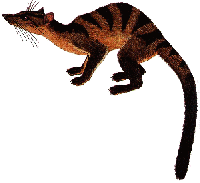 One of the rarest civet species in Sarawak is the banded palm civet. It
has unique coloration, with distinct dark brown or black stripes across its back
a buffy brown to reddish-brown background. Its face and part of its tail is also
striped. Banded palm civets travel and feed mainly on the ground but rest in
holes either in the ground or in trees. Their diet includes earthworms, insects
and other small animals.
One of the rarest civet species in Sarawak is the banded palm civet. It
has unique coloration, with distinct dark brown or black stripes across its back
a buffy brown to reddish-brown background. Its face and part of its tail is also
striped. Banded palm civets travel and feed mainly on the ground but rest in
holes either in the ground or in trees. Their diet includes earthworms, insects
and other small animals.
The bear cat is neither bear nor cat
Very distinct among the civets, the bearcat or binturong has very
long coarse fur, often tipped with yellow or white on the ears, and a long bushy
tail. Although it is the largest of Sarawak's civets, weighing between 6 - 8 kg,
and rather slow moving, it is well-adapted to life in the trees. It can even
cling on to a branch with its tail, rather like a pangolin. They mark their
trees with the scent produced by the glands under their tail, pressing their
gland to the tree as they climb. The males have also been seen soaking their
tail in urine, probably also to scent-mark their territories. But, when they
have young and live in family groups, it is the female who is in charge.
Bearcats are getting rare across their range because they are in constant
danger of being poached for food or for medicines. Ecologically, they are
important seed dispersers because they eat fruit. And they occasionally eat
rodents too, so they also serve as an environmentally-friendly form of pest
control.
Rare and mysterious animals
Hose's civet has only been reported from the mountains of the northern
part of Borneo and we know little about it. Its back is dark brown and its belly
white. Its feet are hairy and partly webbed, suggesting that it may specialise
in foraging for small animals in mossy boulders and streams. It is also known to
feed on small insects.
Otter-civets are equally mysterious, but not at all like the other
civets. They look rather like otters and even have partially webbed feet,
adapted for swimming rather than climbing. They are well-equipped for life in
the water, with their dense fur, valve-like nostrils and thick whiskers.
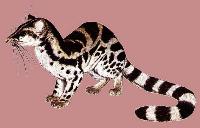 The banded linsang is one of the most beautiful members of the civet
family. It has pale yellow and large transverse bands on its back, with a
beautifully banded tail almost as long as its entire body. Their long and
slender bodies, short legs, and long tail for balance, are well suited for
running through the trees and jumping between branches. When hunting, their
slender bodies move snake-like along the path of the prey, and they are very
well camouflaged by their coats. Their diet includes small mammals, birds,
reptiles and arthropods. Banded linsangs are found in tall and secondary
forests, and occasionally in plantations and gardens.
The banded linsang is one of the most beautiful members of the civet
family. It has pale yellow and large transverse bands on its back, with a
beautifully banded tail almost as long as its entire body. Their long and
slender bodies, short legs, and long tail for balance, are well suited for
running through the trees and jumping between branches. When hunting, their
slender bodies move snake-like along the path of the prey, and they are very
well camouflaged by their coats. Their diet includes small mammals, birds,
reptiles and arthropods. Banded linsangs are found in tall and secondary
forests, and occasionally in plantations and gardens.
 Civet or civet
cat,any of a large group of mostly nocturnal mammals of the Old World
family Viverridae (civet family), which also includes the mongoose.
Civets are not true cats, but the civet family is related to the cat family (Felidae).
Most civets have catlike bodies, long tails, and weasellike faces. Their fur may
be gray or brown, and may be marked in various patterns. All civets have
scent-producing glands, located in a double pouch near the genitals. The fatty
yellow secretion of these glands has a distinctive musky odor used for
territorial marking. Commercially, this substance is known as civet and is used
as a perfume fixative. Civet can be removed from captive animals every 14 to 20
days. Some civet species are hunted for their fur. The ground-living, or true,
civets form a distinctive group within the family; these animals have a highly
carnivorous diet. Most have dark spots and ringed tails. They include several
Asian species (genus Viverra) and one African species (Civettictis
civetta). Best known is the Indian civet, V. zibetha, of S Asia, from
which most of the civet for perfume is derived. It has tawny fur with black
spots and black bands on the tail. It is about 30 in. (76 cm) long, excluding
the 20-in. (42-cm) tail, and about 15 in. (38 cm) high at the shoulder; it
weighs up to 25 lb (11 kg). Its musk glands are greatly enlarged. Some of the
ground-living civets are called linsangs and genets. The palm civets form
another distinct group within the civet family. These are arboreal, largely
fruit-eating animals of Africa and Asia; they are classified in several genera.
The North American spotted skunk is sometimes popularly called civet but is not
closely related to civets. Civets are classified in the phylum Chordata,
subphylum Vertebrata, class Mammalia, order Carnivora, family Viverridae.
Civet or civet
cat,any of a large group of mostly nocturnal mammals of the Old World
family Viverridae (civet family), which also includes the mongoose.
Civets are not true cats, but the civet family is related to the cat family (Felidae).
Most civets have catlike bodies, long tails, and weasellike faces. Their fur may
be gray or brown, and may be marked in various patterns. All civets have
scent-producing glands, located in a double pouch near the genitals. The fatty
yellow secretion of these glands has a distinctive musky odor used for
territorial marking. Commercially, this substance is known as civet and is used
as a perfume fixative. Civet can be removed from captive animals every 14 to 20
days. Some civet species are hunted for their fur. The ground-living, or true,
civets form a distinctive group within the family; these animals have a highly
carnivorous diet. Most have dark spots and ringed tails. They include several
Asian species (genus Viverra) and one African species (Civettictis
civetta). Best known is the Indian civet, V. zibetha, of S Asia, from
which most of the civet for perfume is derived. It has tawny fur with black
spots and black bands on the tail. It is about 30 in. (76 cm) long, excluding
the 20-in. (42-cm) tail, and about 15 in. (38 cm) high at the shoulder; it
weighs up to 25 lb (11 kg). Its musk glands are greatly enlarged. Some of the
ground-living civets are called linsangs and genets. The palm civets form
another distinct group within the civet family. These are arboreal, largely
fruit-eating animals of Africa and Asia; they are classified in several genera.
The North American spotted skunk is sometimes popularly called civet but is not
closely related to civets. Civets are classified in the phylum Chordata,
subphylum Vertebrata, class Mammalia, order Carnivora, family Viverridae.
 commonly
in the United States and the second is the Mexican species. In the United
States, they range as far north as Colorado and as far east as Texas,
being a fairly common animal. They prefer living in areas with a lot of
trees, but are known to make their homes in other places, such as caves,
rock hollows, and other dark, private places where they can rest and feed
with their mate. They are the state mammal of Arizona, and can be found
sleeping during the day in crevices all along mountainsides in the vast
Arizona desert. Ringtail Cats will line these crevices with soft grasses
or moss. Their diet is made up mostly of smaller animals and insects, like
beetles, and they will occasionally eat fruits and vegetables from nearby
vegetation. Ringtails love to climb trees and leap from branch to branch,
being very fast, agile creatures that can run swiftly from predators and
easily close in on slower-moving prey. They are quiet, solitary animals,
and prefer to live alone. They are nocturnal, and forage for food mostly
at night.
commonly
in the United States and the second is the Mexican species. In the United
States, they range as far north as Colorado and as far east as Texas,
being a fairly common animal. They prefer living in areas with a lot of
trees, but are known to make their homes in other places, such as caves,
rock hollows, and other dark, private places where they can rest and feed
with their mate. They are the state mammal of Arizona, and can be found
sleeping during the day in crevices all along mountainsides in the vast
Arizona desert. Ringtail Cats will line these crevices with soft grasses
or moss. Their diet is made up mostly of smaller animals and insects, like
beetles, and they will occasionally eat fruits and vegetables from nearby
vegetation. Ringtails love to climb trees and leap from branch to branch,
being very fast, agile creatures that can run swiftly from predators and
easily close in on slower-moving prey. They are quiet, solitary animals,
and prefer to live alone. They are nocturnal, and forage for food mostly
at night.
 WHO 的 SARS
主管斯多爾說,這種病毒是否存在自然界還不確定,不過如果病毒侷限在養殖動物,那麼只要禁止這種養殖就可以消滅病毒來源,減少日後從動物傳染給人類的可能性。他說:「我們相信現在還來得及撲滅這種疾病,在確定動物來源後,這種可能性更大。」
WHO 的 SARS
主管斯多爾說,這種病毒是否存在自然界還不確定,不過如果病毒侷限在養殖動物,那麼只要禁止這種養殖就可以消滅病毒來源,減少日後從動物傳染給人類的可能性。他說:「我們相信現在還來得及撲滅這種疾病,在確定動物來源後,這種可能性更大。」

 The masked palm civet is named for dark patch from its eyes to the tip of
its nose, just like a mask on its yellowish-white face. Its body is a dark
reddish-brown with yellow-grey underfur. Like the common palm civet, it is
nocturnal, though occasionally it is active during the day. It sleeps in tree
holes or forks in large trees, and its diet includes fruits and small animals.
It occurs in tall and secondary forests, and can also be found in plantations
and gardens.
The masked palm civet is named for dark patch from its eyes to the tip of
its nose, just like a mask on its yellowish-white face. Its body is a dark
reddish-brown with yellow-grey underfur. Like the common palm civet, it is
nocturnal, though occasionally it is active during the day. It sleeps in tree
holes or forks in large trees, and its diet includes fruits and small animals.
It occurs in tall and secondary forests, and can also be found in plantations
and gardens.
 One of the rarest civet species in Sarawak is the banded palm civet. It
has unique coloration, with distinct dark brown or black stripes across its back
a buffy brown to reddish-brown background. Its face and part of its tail is also
striped. Banded palm civets travel and feed mainly on the ground but rest in
holes either in the ground or in trees. Their diet includes earthworms, insects
and other small animals.
One of the rarest civet species in Sarawak is the banded palm civet. It
has unique coloration, with distinct dark brown or black stripes across its back
a buffy brown to reddish-brown background. Its face and part of its tail is also
striped. Banded palm civets travel and feed mainly on the ground but rest in
holes either in the ground or in trees. Their diet includes earthworms, insects
and other small animals.
 The banded linsang is one of the most beautiful members of the civet
family. It has pale yellow and large transverse bands on its back, with a
beautifully banded tail almost as long as its entire body. Their long and
slender bodies, short legs, and long tail for balance, are well suited for
running through the trees and jumping between branches. When hunting, their
slender bodies move snake-like along the path of the prey, and they are very
well camouflaged by their coats. Their diet includes small mammals, birds,
reptiles and arthropods. Banded linsangs are found in tall and secondary
forests, and occasionally in plantations and gardens.
The banded linsang is one of the most beautiful members of the civet
family. It has pale yellow and large transverse bands on its back, with a
beautifully banded tail almost as long as its entire body. Their long and
slender bodies, short legs, and long tail for balance, are well suited for
running through the trees and jumping between branches. When hunting, their
slender bodies move snake-like along the path of the prey, and they are very
well camouflaged by their coats. Their diet includes small mammals, birds,
reptiles and arthropods. Banded linsangs are found in tall and secondary
forests, and occasionally in plantations and gardens.